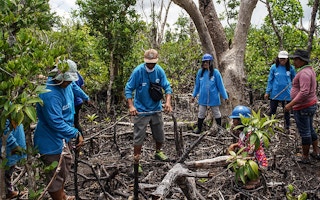Expanding aquaculture in South East Asia over the last two decades has been the main driver of mangrove loss in the world, says a study published in PLOS One this month (June).
The study, conducted by a team of scientists at Global Mangrove Watch (GMW), mapped the distribution and changes of mangrove ecosystems in the world during 1996 — 2010 using satellite imagery. The team analysed 1,168 mangrove areas in North, Central and South America, Africa, Middle East, India, and South East Asia.
Nathan Thomas, lead author of the study, found 38 per cent of mangrove areas observed in the study are affected by human activity. South East Asia, home to 33.8 per cent of the world’s mangroves, as well as 90 per cent of the world’s aquaculture, was the worst affected region with half of its mangrove areas suffering degradation.
“
Aquaculture (shrimp farming) and agriculture (oil palm, rice) were evaluated to be the greatest drivers of mangrove deforestation in the region.
Nathan Thomas, scientist, Global Mangrove Watch
“Mangroves are being threatened across their entire range and have suffered large losses over the past century, primarily due to increasing coastal populations and the conversion of mangroves to aquaculture,” says Thomas, currently a post-doctoral scholar at the California Institute of Technology Jet Propulsion Laboratory.
“Aquaculture (shrimp farming) and agriculture (oil palm, rice) were evaluated to be the greatest drivers of mangrove deforestation in the region,” says Thomas.
Mangroves, especially of the Rhizophoraceae family, are maritime trees or shrubs that form dense masses of roots and foliage that naturally protect coastal ecosystems against storms and sea-level rise.
Mangroves provide livelihoods through fishing and timber and help mitigate climate change by acting as carbon sinks. The word ‘mangrove’ refers to mangrove forests as well as to the trees.
Cecep Kusmana, expert on mangrove ecology at Bogor Agricultural University, West Java, says that Indonesia is home to 3.7 million hectares of mangroves with 70 per cent of it damaged or degraded by aquaculture and human settlement. But Kusmana is optimistic because governments, international NGOs, and coastal people are now working together to rehabilitate mangroves.
“There is growing awareness among coastal communities in Indonesia concerning the role of mangroves for economic livelihoods and disaster mitigation. I witnessed mangrove rehabilitation by coastal communities in East Java, North Sumatra, South Sulawesi, and the north of Jakarta.”
“This is something good for us even though I know that the rate of mangrove degradation and deforestation is still higher than its rehabilitation rate,” says Kusmana.
He says coastal communities are now trying to balance sustainable aquaculture with mangrove conservation.
At Serdang Bedagai, North Sumatra, people conserve mangroves at the centre of their shrimp farms and plant oil palm along the borders.
“I think this is the best way to conserve mangroves as well as to improve the livelihoods of poor communities that live around them,” adds Kusmana.
GMW is an international project that begun in 2011 led by the Japan Aerospace Exploration Agency in collaboration with a host of other institutions including Aberystwyth University (UK) and the National Aeronautics and Space Administration.
This piece was produced by SciDev.Net’s Asia & Pacific desk.

















